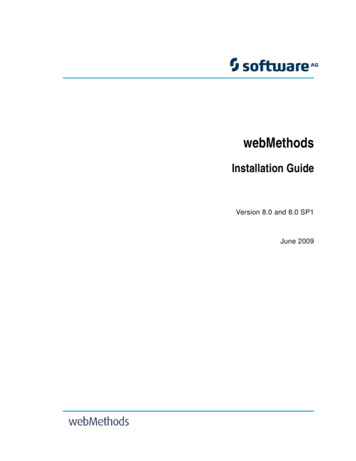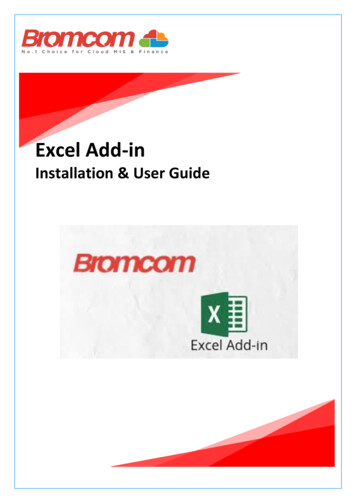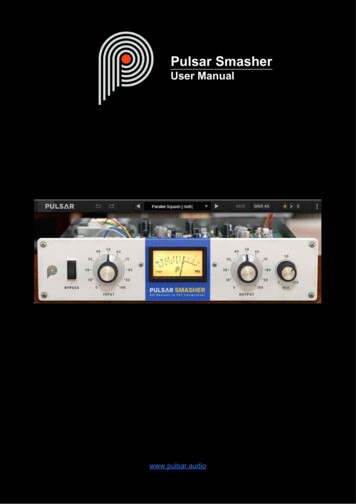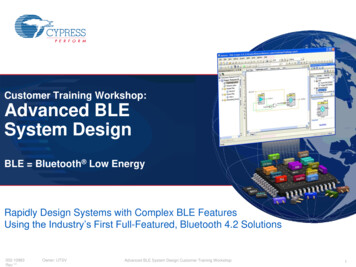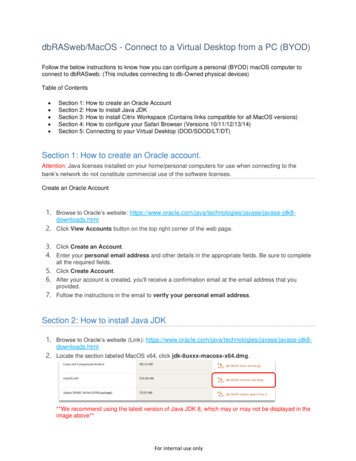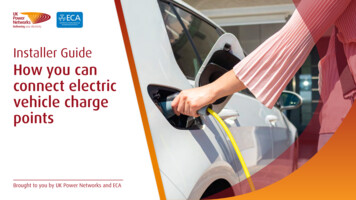
Transcription
Installer GuideHow you canconnect electricvehicle chargepointsBrought to you by UK Power Networks and ECA
ContentsList of Acronyms3Information4TT15Providing TT earthing for the EVCP16UK Power Networks Intro51. Separation distance from buried underground services16ECA Intro52. Exposed and extraneous-conductive-parts16In this guide53. Simultaneous contact assessment16Brief on the changing electrical landscape regarding future electrical systems64. Hazards of hidden underground services16Installation processes85. Electrode corrosion16Connection requirements from DNOs7DNO connection types for EV chargers7DNO process for a single EV charger7Summary of ENA process: Installer Checklist8Converting building from TN-C-S to TT earthing system1717Earth electrode resistanceInspection and testing requirements18Continuity of conductors19DNO Process for installing large or multiple chargers.10Insulation resistance19Installing chargers on the public highway10Polarity19Technical Considerations11Earth electrode testing19EVCP Location11Earth fault loop impedance1911RCD testing19Determining Maximum demand12Phase sequence (3 phase)19Site survey and permissions12Functional Testing19Considerations for communication connectivity13V2G EV Chargers19Surge Protection Devices13Other useful links20Installing EVCPs in potentially explosive atmospheresEarthing Arrangements14TN-C-S and TN-S14Note: Open-PEN devices and onsite generation / EESS issues15Protective Measure: Electrical Separation (722.413)15ECA Members21Guide to the Process of Connection for Electrical Vehicle Charging Points2
List of AcronymsACBNOCTAlternating currentBuilding Network OperatorCurrent transformerMETMOCOPAOfgemMain earthing terminalMeter operation code of practice agreementOffice of gas and electricity marketsDNODistribution network operatorOZEVOffice for zero emission vehicles (previously OLEV)ECAElectrical Contractors AssociationPENProtective earthed neutralEESSElectrical energy storage systemPMEProtective multiple earthingsENAEnergy Networks AssociationRCDResidual current deviceElectricity safety, quality and continuity regulationsSMESmall to Medium EnterprisesElectric vehicleSPDsSurge protection devicesEVCPElectric vehicle charge pointSPNSingle Phase networkEVCEElectric vehicle charging equipment (may offer multiple EVCPs)TPNThree phase networkGSMGlobal system for mobile communicationsUKPNUK Power NetworksHSEHealth and Safety ExecutiveUMCUn-metered connectionIETInstitute of Engineering & TechnologyV2GVehicle to gridESQCREVGuide to the Process of Connection for Electrical Vehicle Charging Points3
InformationIntroductionUK Power NetworksECAWe are the UK’s largest distribution network operator (DNO).We own, maintain and operate all of the wires, cables andsubstations of the electricity distribution network across London,the South East and East of England. Our core role is to keep powerflowing safely, efficiently and reliably while providing excellentcustomer service to more than eight million homes and businessesin their areas.ECA is the UK’s largest trade association representing electrical,electrotechnical and other engineering contractors in England, Wales andNorthern Ireland at regional, national and European level. ECA Membercompanies are rigorously assessed before membership is approved.We also have a critical role at the heart of the future energylandscape, enabling the transition to Net Zero carbon emissionsby connecting renewable energy, electric vehicles and heat pumps.They have a combined turnover in excess of 6 billion annually. Memberfirms carry out design, installation, inspection, testing, maintenance andmonitoring activity across the domestic and commercial and industrialsectors. This ranges from power and lighting to data communications, toenergy efficiency and renewables, as well as the design and installationof cutting-edge building control technologies.ECA’s 2,700 members range from SME electrical firms to nationwideengineering contractors and building services firms that employthousands of professionals on major UK projects. ECA Members alsosupport over 5,000 apprentices annually.Guide to the Process of Connection for Electrical Vehicle Charging Points4
InformationIn this GuideThis is a technical guide for electric vehicle charge point(ECVP) installers. Based on their feedback, the guide will helpinstallers through the connection process and highlights themain considerations when installing electric vehicle chargers.View the current IET code of practice for electric vehiclecharging equipment installation'.Connection requirementsfrom DNOsDNO connection types for EV chargersThere are nine different type of suppliesthat can be used for EV charge points onUK Power Networks. These are summarisedin Table 1 on page 8. Check what DNOsupplies any property by checking here:Find your energy supplier Energy Networks Association (ENA)Guide to the Process of Connection for Electrical Vehicle Charging Points5
InformationBrief on the changing electrical landscaperegarding future electrical systemsIn the UK, the sale of new petrol and diesel cars and vans will endby 2030. This is one of the major actions cementing the UK’s globalleadership on tackling climate change. There are already over halfa million EVs registered in the UK. UK Power Networks’ distributionarea is currently at the forefront of the switch, with an estimated29% of all vehicles in our licence areas. Despite the impacts ofthe COVID-19 pandemic, 2020 saw the biggest annual rise in thenumber of EV registrations; increasing the total number of EVs byover 70% within one year.Channel Islands51Isle of Man64Northern Ireland327North East806Wales856East Midlands1,189Yorkshire and the Humber1,191West Midlands1,358East of England1,424North West1,549South West1,672Scotland2,372South East3,084Greater London7,252SOURCE: ZAP MAP STATSFigure 1 Number of devices per region (April 2021)Guide to the Process of Connection for Electrical Vehicle Charging Points6
InformationBrief on the changing electrical landscaperegarding future electrical systemsThe vast majority of EV charging takes place at home, with only 18% of charginghappening at work, en route or at destination. This is projected to change slightlyover the next decade, with more charging happening at work or at destination.There are now 40,000 public charge point connectors spread across 15,000 locations in theUK. The rate of installation in 2021 is on track to deliver almost 7,500 new chargers, which istwice as many charge points as were installed in 2020. Despite this improvement, a surveyby the Electric Vehicle Association revealed that overall satisfaction rating with the state ofpublic charging infrastructure was just 2.16 out of 5.Figure 2 Charging segments in 2019 vs charging segments in 2028DestinationEn-routeAt Work8%7,0009%En-route8%At homeon street19%TODAY62%5,9176,000off streetAt home7,3108,000Destination4%6%Figure 3 Public charge devices installed in the UK per annum5,000At Work19%202838%At homeoff streetAt home on 018Slow2019Fast2020Rapid2021projectedUltra RapidSOURCE: ZAP MAP STATSGuide to the Process of Connection for Electrical Vehicle Charging Points7
installation processesTable 1: EVCP supply overview (replicated from EDS 08-5050)InstallationprocessesDNO process for asingle EV chargerWhilst each Distribution Network Operator has their owntechnical standards, they all follow the same processwhich is published by the Energy Networks Association.The customer or a competent tradesperson must assesstheir installation to determine what is required. The twopossibilities are:- Connect and notify- Apply to connectThe same form is used in both instances. However,for any installations in the UK Power Networks licencearea, Smart Connect can be used.xTypeTotal MPRAvailable (kVA)UMC5.75100A SPN Highway23100A TPN Highway69100A SPN Domestic23100A TPN Domestic69Large LV 1500*HV SuppliesLimited by MPREHV SuppliesLimited by MPRMulti-Occupied BuildingLimited by MPRMax Single EVCP (Typical CPs)Sections3kW7kW15kW22kW50kW xxxx5.1 * † †x5.2 † †5.3xx5.4 †x5.4 *5.5 * * * * * * * * * * * † † † * * * * * * * * * * *5.55.55.5Not possible from this connection type. Possible to connect without additional assessment. † Possible to connect subject to thermal capacity and harmonic assessment, refer to section 5.5. * Possible to connect multiplr EVCPs available subject to thermal capacity and harmonic assessment of an existing or proposed connection type.SPN – single phase network TPN – three phase network UMC – unmetered connectionGuide to the Process of Connection for Electrical Vehicle Charging Points8
installation processesSummary of ENA process: Installer Checklist1. Features of the connectiona. Do you know the DNO cut-out rating? If the cut-out rating is unknown or uncertain,it can be established by raising an enquiry with the DNO. Please note that only aDNO or their approved persons can pull cut-out fuses.b. Is the service looped? Some DNO cut-outs have more than one DNO service cableterminated in the cut-out. Looped services can be found anywhere but are oftenfound in rural areas and terraced housing.c. Is the supply unmetered?2. Safety checka. Do you have any concerns over the adequacy of the DNO service equipment? Anyconcerns should be reported to the DNO. Guidance can be found in the MOCOPAdocument on the specifics, and examples of various cut-outs in the ENA documentIf any of these are applicable, you must apply to connect Customer has a looped or unmetered supply It is a DC EV charge point Max demand above 13.8 kVA without a CT metered supply Max demand above 13.8 kVA and max AC output of the EVCP is greater than 30%of the Max Import Capacity. (note:this is specific to UK Power Networks) Alternatively, if there is not the required capacity and the client isn’t willing to pay foradditional capacity, then the maximum charge capacity could be restricted within theEVCE, to allow the total energy demand to remain within the limits of the supply.This is often a simple procedure such as altering the setting of a potentiometer.3. Maximum demanda. Does the max demand exceed the cut-out rating? Maximum demand is the highestlevel of new demand that could occur on the whole customer connection and includesall new HP and EV devices. The maximum cut-out rating may be visible on the cutout. Ratings below 60 A are possible (e.g. 30 A, 40 A and 45 A), especially in ruralareas. Note that the cut-out rating will be reduced from its stated value if the ambienttemperature at the cut-out location is high e.g. due to inadequate ventilation, adjacentheat sources etc.b. Is the max demand greater than 13.8k VA per phase? IET Guidance Note 1, AppendixH gives qualified electricians guidance on the assessment of Maximum Demand forthe whole customer connection.Smart ConnectSmart Connect can be used for EV Charge Pointconnections within a single premise or domesticproperty, which has an existing electricity connectionof up to a three-phase supply with 100 A per phase.It can be used for regular charge points as well asvehicle-to-grid (V2G) charge points. It can also be usedfor installing battery storage, solar PV or a heat pump.Note: No diversity is permitted for the EVCP circuit although load curtailment (eitherreduction or disconnection) may be taken into account as per regulation 722.311.201Guide to the Process of Connection for Electrical Vehicle Charging Points9
installation processesSmart Connect has all of the requirements from theENA process built into it, and includes an automatedassessment to reduce processing times.DNO Process for installinglarge or multiple chargersMore information including a link to register andaccess the tool:Smart Connect UK Power NetworksWhether you are installing Electric Vehicle Charge Pointsas part of your development or looking to build a standalonecharging hub, UK Power Networks can help ensure you getthe most efficient, cost effective connection to the network.We have introduced specialist pre-application support tomake sure you get your application right first time.More information here:Installing larger or multiple chargers UK Power NetworksInstalling chargers onthe public highwayDNOs provide metered electricity connections to electricvehicle charging points on the public highway. For safetyand reliability, it is vital the appropriate standards arefollowed. To set up an electric vehicle charging point on thehighway you should complete a Highway Metered ServicesRequest form.More information can be found at:Highways UK Power NetworksTown and countryplanning order 2015This is an important rule for charging installers.It states that planning is not required forinstallation of an upstand with an electricaloutlet mounted on it for recharging electricalvehicles so long as the area is lawfully usedfor off-street parking. However local controllingauthority permission may be required dependingon the circumstances of the installation.For on-street public charging equipment aTraffic Management Order (TMO) may berequired, which can result in a long lead time.Guide to the Process of Connection for Electrical Vehicle Charging Points10
Technical ConsiderationsTechnical ConsiderationsEVCP LocationIt is important to carefully consider the following points when decidingon the location of an EVCP: P otential trip hazards, such as trailing charging leads should be avoided Tethered cable storage should be made available S pace should be considered for suitable ventilation particularly for rapidand ultra-rapid DC charging equipment E ase of access and maintenance should be factored in to any design C hargers should be provided with mechanical protection from impact bya vehicle through such measures as, bollards, tyre stops or a protective cageInstalling EVCPs in potentiallyexplosive atmospheresEVCP should not be located in areas where a potentiallyexplosive atmosphere exists. It is essential that any EVCPequipment and potential connected vehicles are locatedoutside of defined hazardous zones.For installations on Petrol Retail Forecourts, installers arerequired to be trained and qualified under the Petrol RetailForecourt Contractors Safety Passport Scheme, and / orunder CompEx.If a separate electricity supply is provided for the EVCP, itis important that the EVCP equipment is connected to thesame TT earthing system as the forecourt (note PME is notpermitted in forecourts). This supply must also be interlockedwith the filling stations main switch. Adequate lighting should also be available for safe connection and use of an EVCP P ublic charging points need to be sited so as to accommodate the widestdiversity of need as per the Equality Act 2010. This will include wheelchairusers, parents and those with mobility issues.Guide to the Process of Connection for Electrical Vehicle Charging Points11
Technical ConsiderationsDetermining Maximum DemandSite survey and permissionsTo identify maximum demand, please refer to existingrecords if they are available, these will often contain theinformation required.It is important to gain permission from the clientwhen conducting site surveys.If existing records are unavailable, the DNO shouldbe contacted to ascertain the available supply.Notify the client or the tenant when the power willbe turned off and consider any mission critical ormedical equipment.UK Power Networks do not permit anyone other than DNOstaff to open the cut-out to confirm the fuse size. UK PowerNetworks will always carry out a free visit to confirm thefuse size: Fuse upgrade UK Power NetworksAlternatively, follow the process of design of theinstallation for maximum demand calculated with diversity.The IET Guidance Note 1: Selection & Erection containsguidance on completing a maximum demand calculation.Note: No diversity is permitted for the EVCP circuit unlessload management is in place.A power and energy logger could also be employedover a period of time to ascertain the load balancefor a 3-phase supply.Clamp meters can be used across each phase, with theclient switching on all equipment (within reason) to give anindication of the demand on the phases. This reading couldthen be compared with the design information if available.Regulation 132.16 states:Additions and alterations to an installationNo addition or alteration, temporary or permanent, shall be made to an existinginstallation, unless it has been ascertained that the rating and the condition of anyexisting equipment, including that of the distributor, will be adequate for the alteredcircumstances. Furthermore, the earthing and bonding arrangements, if necessary for theprotective measure applied for the safety of the addition or alteration, shall be adequate.Guide to the Process of Connection for Electrical Vehicle Charging Points12
Technical ConsiderationsCheck the origin of the installation: Service Cable Service head Earthing arrangement Meter tails Metering equipment Isolator (where present)Check for parallel or switched alternativesources of supply such as: Solar PV Generation equipment Electrical Energy Storage System (battery)Ensure that any additional generation equipment is capablefor the additional EV loading.Is Automatic Disconnection of Supply (ADS) present?Inspect the existing electrical installation and ascertainwhether there are issues which should be resolved prior tothe installation of the EVCE. If this is the case do not do thework until these are rectifiedNote: Make use of the comments box on an installationcertificate highlighting existing works which wouldn’timpede the installation but that the client should beaware of.If connecting the EVCP to a public supply that is unmetered,contact the DNO for a new metered supply. Examples includeon-street parking or carparks where the supply is throughdistribution network operator or a building networkoperator (BNO).If supply is metered and provided by a landlord thenpermission will be needed by them prior to the installationto the supply. If this is refused, then an alternativeconnection will need to be applied for from the BNO or DNO.If the EVCP will require payment for charging, then tariffmetering will need to be provided as per the Electricity atWork Regulations 1989. The selling of electricity for chargingwill require Ofgem compliance as well as making theinstallation not applicable for OZEV funding.Metering may also be required for energy managementas per Building regulations approved documents:L2A: Conservation of fuel and power in new buildings otherthan dwellingsL2B: Conservation of fuel and power in existing buildingsother than dwellingsConsiderations forcommunication connectivityFor increased functionality, such as smart control(programming charge times) Wi-Fi or GSM connectivitymay be required. In areas of poor signal, a hard-wireddata connection could be made back to the router. Specialcables are available combining both power and data. It isrecommended to consult with the manufacturer to verify thesuitability and conformity of cables used.Surge Protection DevicesSPDs are a consideration (see sections 443 / 444 in BS 7671The Wiring Regulations) and are required where beingprovided as a publicly accessible service.A risk assessment according to Regulation 443.5 shall becarried out to determine if SPDs are required except for asingle dwelling unit where SPDs may be omitted where thetotal value of the installation and equipment therein doesnot justify such protection.For commercial installations, SPDs may already be installed.It is important to check the length of the circuit providing theEVCP and if in excess of 10 m a local SPDs should be used.These would likely need to be type 2 due to the limitationsof current rating and cable size attributed to type 3 SPDs.Guide to the Process of Connection for Electrical Vehicle Charging Points13
Earthing ArrangementsEarthingArrangementsTN-C-S and TN-SThe IET Wiring regulations BS 7671 has specific requirementsregarding installing an EVCP on PME earthed systems. Whilstan EVCP is essentially supplied by a straight-forward radialcircuit, additional protection is required to protect against apotential open-PEN event. An open-PEN event is where abreak occurs in the Protective Earthed Neutral (PEN) on thedistribution network supplying the building. Neither circuitbreakers, nor RCDs are able to detect and provide protectionagainst these events. It should be noted that open-PENevents are infrequent and risk of shock from such an eventis minimal.Section 722 of BS 7671 explicitly states that PME isn’tpermitted unless certain conditions are met.Regulation 722.411.4.1 has specific requirements for whenPME earthing can be used which are summarised on thenext column.(i) relies on the principle, that in balanced three phasesystems, the current balance will ‘hold the neutral’ inplace, with respect to reference earth, provided thatcertain issues such as power factor and harmonicsare considered.The designer will have to consider these values in detail,especially the likelihood of the load balance beingsustained during the usage and life of the installationas it is difficult to protect against future changes to theelectrical system, including external influences for otherbuildings. Long term power monitoring recommended forcommercial installations to correctly identify the loadingand balance.(ii) , relies on the principle of an additional earth electrode –supplementing the TN-C-S earthing facility, and providingsufficiently low earth loop impedance at all materialtimes to limit shock voltages, should the main PME penconductor fail to open circuit.BS7671 A722.3 gives a useful equation that may be usedin this respect as well as useful information in AnnexGof IET code of practice for electric vehicle chargingequipment installation 4th editionbe arrived at. It will be found however, that this electrodeimpedance will be very low – typically in the order of10 ohms or less, which may be impracticable, or oftenimpossible to achieve - even with multiple electrodes.(iii) relies on a specific Open PEN detection device, whichmonitors the voltage between the installation earthconnection and a reference true earth taken at asampling electrode. Should a dangerous touch voltageoccur between these two references, exceedinga specified time, the device disconnects the liveconductors and the source earth connection – in apredetermined time sequence. An earth electrodeis required to monitor the true voltage differentialbetween the installation earth and true earth (this ofcourse would not need to be sized to ‘shunt’ any faultcurrent as would be the case with a TT Earth electrode).(iv) this permits the use of an open-PEN detection devicewhich provides protection by monitoring the utilisationvoltage at the chargepoint and disconnecting allconductors (line, neutral and earth), should theutilisation voltage at the charging point go above orbelow 10% of the nominal voltage (207V -253V). Thisdevice can either to be built into the EVCE but could alsobe employed in series.The designer will however have to ascertain themaximum demand current of the whole installation ifsingle phase, or the maximum neutral current for thewhole installation if three-phase. Once this has beenassessed and the equation applied, suitable maximumearth impedance for the supplementary electrode(s) canGuide to the Process of Connection for Electrical Vehicle Charging Points14
Earthing ArrangementsNote: When an installation is deemed single phase, it isimportant to use a single phase protective device satisfying722.411.4.1(iv) and where deemed three phase to use athree phase device satisfying 722.411.4.1(iv). If the situationis ambiguous for any reason, (such as a lack of access), theadvice is to speak to the open PEN device manufacturer forclarification on the particular case at hand. (For example- anindustrial unit with a single-phase supply, being taken froma three-phase main supply).(v) allows a new technology to be used that can provideprotection to EVCPs that is no less safe than thosepermitted in BS 7671:2018 amendment 1.Note: Open-PEN devices and onsite generation / EESS issuesNote: Installations with onsite generation and / or ElectricalEnergy Storage Systems (EESS) may inadvertently causethese devices to trip. In order for generation and EESS tobe able to ‘push’ their energy onto the network / buildingsupply, they export at a voltage above that detected by thesupply. If the building is connected to a network with a highsupply voltage (ESQCR permits 230 V 10% / -6%), this couldresult in export voltages above the 253 V permitted by thesedevices. This is likely to be exacerbated on very sunny dayswhere a PV system is operating at maximum capacity.Conversely, under voltage may also present itself. TheESQCR permits 230 V – 6% as the minimum supply voltageequating to 216 V. If the maximum rated voltage drop (5%)for an installation is applied (230 x 0.05) 11.5 V can be lost.This would then lead to a voltage of 216 V – 11.5 V 204.5Vbeing detected at the EVCP or at the O-PEN monitoringdevice where it is installed at the end of the radial circuit. Ifthis is the case, it may therefore be prudent to design thecircuit provided for the EVCP with a lower volt-drop of 1-2%to prevent this, although this would entail using conductorswith an increased cross-sectional area.Some open-PEN detectors are designed to be located at theorigin of the circuit thus eliminating this issue.Protective Measure:Electrical Separation (722.413)Electrical separation is an option for providing protectionagainst open PENs for an EVCP. This would be through theuse of a fixed isolation transformer. However, these can beexpensive, heavy and may prevent certain types of EV fromcharging due to earth referencing required during their initial‘handshake’ with the EVCP.TTFor buildings on an existing TT earthing system, or where thebuilding is being converted to a TT earthing system or wherethe EVCP will solely be connected via TT earthing system.In these situations, specific RCD / RCBOs must be used. Eithertypes A, B or F.If an additional upstream 30 mA RCD is provided in theconsumer unit, additional protection will be provided forthe cabling to the EVCP. If the EVCP is to be installed usingsurface mounted cabling or through the use of SWA orsimilar, an upstream RCD is not required.If a type A RCD is used to protect an EVCP without RDC-DDthis should not be installed downstream of a standard typeAC RCD as this may impair its functionality. The installershould consult with the EVCP manufacturer to clarify therequirements.Note: TN-SUnless it can be guaranteed that the supply to the buildingis TN-S all the way back to the sub-station, it should beassumed to be a TN-C-S PME system, even if they wereoriginally constructed using separate neutral and earth(SNE) cables. However, for a private network where it isguaranteed to be TN-S, no special conditions apply and theEVCP can be connected as a straight-forward radial circuit.Guide to the Process of Connection for Electrical Vehicle Charging Points15
Earthing ArrangementsProviding TT earthing for the EVCPOne option is for the EVCP to have its own TT earthing arrangement.However, this may not always be the best solution as there are specific considerationsto take into account such as:1. Separation distance from buried underground servicesIt may not always be possible to provide sufficient separation from buried metalworkconnected to the supply PEN conductor. If an open-PEN fault condition was to occur,any voltage that appears on buried metal work connected to the PEN conductor mayalso appear on the vehicle or the EVCP connected via the earth electrode. It is thereforeimportant to consider the distances between electrodes and buried metallic services.Table 3 shows the recommended minimum separation distances below ground betweenburied conductors and earth electrodes of a TT system from those connected to a PMEor TN-S earthing system:More information can be found in annex H of the IET Code of Practice for Electric VehicleCharging Equipment Installation.2. Exposed and extraneous-conductive-partsIt is also important to ensure that simultaneous contact between exposed or extraneousconductive-parts connected to the TN-C-S supply and the electric vehicle is not possible.This includes any parts on neighbouring properties.3. Simultaneous Contact AssessmentRegulation 411.3.1.1 states that:Simultaneously accessible exposed-conductive-parts shall be connected to the sameearthing system individually, in groups or collectively.Therefore, if an EVCP is installed on a TT earthing system, it is important to ensure thatpersons cannot simultaneously touch the EV, and another exposed extraneous partthat is connected to a differing earthing system such as the building, or neighbouringbuildings TN-C-S. It is essential that a simultaneous contact assessment is carried out.4. Hazards of hidden underground servicesWithout the use of specialist equipment, such as a cable avoidance tool, it is difficultto identify hidden unmapped underground services. These could include electric cables,gas pipes and water pipes. There is obviously a danger to the installer and the clientif these are damaged through the installation of an earth electrode.The Health and Safety Executive (HSE) guidance HSG47 offers advice on avoidingdangers from underground services.5. Electrode CorrosionEarth electrodes will corrode over time and eventually may need to be replaced.It is therefore important that testing of the electrode is noted as being required onfuture servicing and maintenance.Note: Multiple EVCPs can be earthed from a single earth electrode connectionTable 3: Recommended minimum separation distances below ground between buried conductors andearth electrodes of a TT system from those connected to a PME or TN-S earthing systemPurpose of TT systemRecommend
Summary of ENA process: Installer Checklist 8 DNO Process for installing large or multiple chargers. 10 Installing chargers on the public highway 10 Technical Considerations 11 EVCP Location 11 Installing EVCPs in potentially explosive atmospheres 11 Determining Maximum demand 12 Site survey and permissions 12 Considerations for communication .


